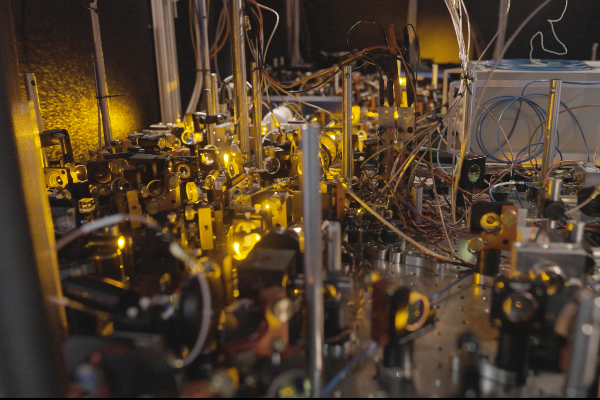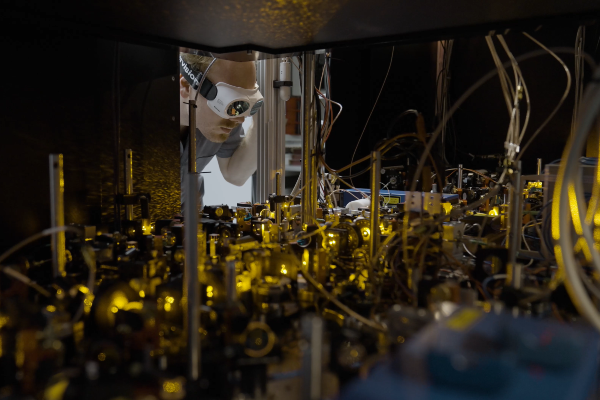A team of researchers at the Max Planck Institute of Quantum Optics (MPQ) and the Cluster of Excellence MCQST has for the first time observed evidence of a phenomenon that had previously only been suspected: a theory predicts that exotic bound states can arise when ultracold polar molecules collide. Visible changes in the collision properties now indicate in the experiment that this effect is indeed possible. For their investigations, the researchers used a specifically shaped microwave field with which they can directly influence the interplay of various forces between the particles. In this way, “supermolecules” can form: comparatively large and just weakly linked constructs that can be controlled by the field of a microwave and whose existence affects the dynamics of collisions between unbound molecules. With the new results, the team created a versatile experimental tool to generate exotic forms of quantum matter from ultracold molecules.
Sodium laser system in the laboratory of Immanuel Bloch
The system is generating the yellow light used for laser cooling and imaging of sodium atoms.
© MPQ
About 20 years ago, the US scientist John Bohn and his colleagues predicted based on theoretical considerations and calculations a novel peculiarity of molecules: If the molecules carry an asymmetrically distributed charge – the physicists refer to this as polarity – they can combine in an electrical field to form weakly bound "supermolecules". But an experimental confirmation of the prediction was unavailable – until now. A team of researchers led by Xin-Yu Luo and LMU physicist Immanuel Bloch, Director at MPQ and Head of the Quantum Many-Body Systems Division, now discovered the first indications of the existence of such constructs, which are huge compared to other molecules.
The researchers irradiated an ultracold gas of dipolar molecules with a deformable microwave field and found that the properties of the gas changed greatly – precisely at such field parameters where "upermolecules" should form. “When two polar molecules meet, they behave a bit like two compass needles," explains MCQST scientist Dr Xin-Yu Luo, who heads the team at MPQ. Under the influence of the Earth's magnetic field, both needles point north. The needles aligned parallel in this way repel each other. However, if you bring the needles close enough together, the force acting between them exceeds the effect of the Earth's magnetic field. This allows the needles to align themselves so that they point at each other and thus attract.
Main vacuum chamber of the molecules experiment:
In the middle of the chamber four high-voltage copper wires are routed to an ultrahigh-vacuum glasscell where the ultracold polar molecules were produced.
© MPQ
A similar interplay of different, opposing forces is experienced by two polar molecules when they approach each other in an external electric field. "The resulting interaction can lead to either repulsion or attraction between the molecular electric dipoles," says Luo. The crucial factor is which quantum state the two molecules occupy.
Drastic change of forces
The theory predicts: At suitable settings of the electric field, the two partners connect with each other at a certain distance. For a short time, a “field-linked molecule” is created – a construct that can be up to several hundred times larger than a single, unbound molecule. If the parameters of the electric field are changed a little at the critical value, the forces between the individual molecules change drastically. The scientists refer to this as a resonance phenomenon, which they call "field-linked resonance".
In the experiment, the team at MPQ also found that the collisional properties of sodium-potassium molecules could be altered by tuning the frequency or shape of the microwave field. Therefore, the researchers disturbed the molecular gas with a standing wave of laser light and observed how quickly the disturbance disappeared again through collisions between the molecules. “Finding tuning knobs with which we can control the interaction between ultracold molecules is extremely important for us quantum physicists," says Xing-Yan Chen, who does his PhD on this experiment.
View of the experimental setup in Immanuel Bloch's laboratory
© MPQ
Rotating fields
Although the underlying theory is widely accepted, it had not been possible to observe such resonances in experiments until now. "It was assumed that extremely high field strengths would be required to form a field-bound molecule," explains Dr Andreas Schindewolf, another researcher in the team. "The applied microwave field usually rotates in a circle like the hand of a clock."
The scientists had used such a field in 2022 to stabilise ultracold molecules, creating the coldest dipolar molecules in the world. "Surprisingly, we found that an unintentional deformation of the microwave field – like a transition to a clock with an elliptical dial – induced the resonance behaviour," Schindewolf reports. Spurred on by this observation, the researchers developed a special microwave antenna to deform the field in a controlled manner and thus characterise the resonance.
With the ability to control the interaction between polar molecules through the field-linked resonances, we can now experimentally generate exotic quantum matter
Prof. Immanuel Bloch
Generating exotic quantum matter
"With the ability to control the interaction between polar molecules through the field-linked resonances, we can now experimentally generate exotic quantum matter," says LMU-physicist Immanuel Bloch. This should allow in the future to impart superfluid properties to a molecular gas. "Further insights could be gained into how particles pair up in a superfluid or superconductor."
“The field-linked resonances could also permit the realisation of so-called suprasolids with molecules – a state that simultaneously exhibits properties of a superfluid and a solid.", says Xin-Yu Luo. Ultimately, the researchers aim at using the resonances to specifically combine individual molecules into field-linked molecules so they can stabilise the supermolecules and exploit their exotic quantum properties.
Xing-Yan Chen, Andreas Schindewolf, Sebastian Eppelt, Roman Bause, Marcel Duda, Shrestha Biswas, Tijs Karman, Timon Hilker, Immanuel Bloch & Xin-Yu Luo. Field-linked resonances of polar molecules. Nature 2023.



